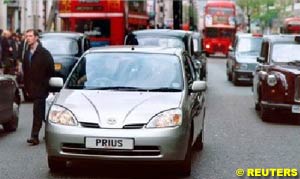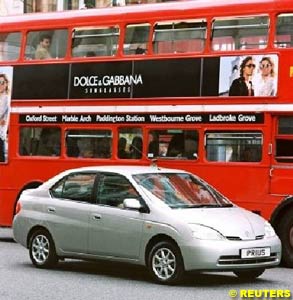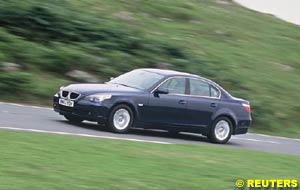

Automotive News and Reviews for the Petrolhead
Reuters Motoring Commentator
In this week's issue:
- Toyota leads race for greener cars
- Road test: Gimme Five
- Porsche moves out of fast lane with Cayenne V6
You could call it one of the biggest upsets in the global car industry's century-old competition. Toyota Motor began learning how to build cars 66 years ago by taking apart a Chevy sedan in an empty warehouse. But now it is forcing bigger rivals to play catch-up in the race to offer greener cars.
Moreover, Toyota's new hybrid gasoline-electric Prius sedan promises to be the first car that can park itself without the driver having to touch the steering wheel, using electrically operated power steering and sensors that help guide the car when reversing into parking spaces.
Toyota President Fujio Cho sat in the driver's seat at a demonstration on Monday this week laid on for the press, surprising reporters by holding his hands up as the car quickly parked itself. "I forgot to put on the brake," Cho said. "But it's easy."
Since the first Prius debuted in 1997, Honda Motor Co Ltd has been the only other car maker to put mass-market gas-electric hybrids on the road. The excuse offered by laggards, including Chevrolet maker General Motors Corp, was that developing hybrids was a waste of time and money since they were only a short-term solution until no-emission fuel-cell vehicles (FCVs) took over.
Hybrids use electric motors and battery packs to improve fuel efficiency, adding power during acceleration and reclaiming energy when braking and coasting, but still need gasoline to run.
"Others are going to have to step up plans to develop hybrids too," Hiroyuki Watanabe, Toyota's senior managing executive in charge of the hybrid business, told Reuters last week.
That, albeit belatedly, is the plan for many big auto makers. Later this year, the world's top two, GM and Ford Motor Co, will begin selling hybrids to fleet customers, and next year offer them to retail customers - seven years behind Toyota.
From Niche to Mainstream?
Gasoline-electric hybrids are the most fuel-efficient mass-market vehicles on the road now, with a four-seater offering between 45 to 52 miles per gallon - about twice that of comparable gasoline-powered cars.
Toyota has sold about 150,000 units cumulatively since December 1997, and has promised to offer the power plant on most of its models in the near future. It hopes to sell 300,000 hybrids a year by 2005 - an aim Watanabe admits is ambitious.
"It's a very tough goal," he said.
To help reach the target, Toyota is discussing supplying hybrids to other auto makers. It already has an agreement with Japan's Nissan Motor Co Ltd - also one of the initial sceptics -- which plans to sell its first hybrid vehicle in 2006.
Auto industry researcher J.D. Power recently forecast that in 10 years, one in every 20 cars sold in the United States would be a hybrid against one in 442 last year, as the power plant is offered in a wider range of vehicles. In a few years, competition will be in full swing as Toyota's share of the U.S. hybrid market drops to 26 percent from half now, while GM takes a quarter and Ford grabs 16 percent, it said.
Long Road Ahead
While the road seems to be mapped out for hybrids in the United States, they are still far from catching on globally.
Despite the higher price of petrol elsewhere, hybrids only enjoy mild acceptance in Japan and virtually none in Europe.
Europeans are keener on diesel, which is cheaper and more fuel-efficient than gasoline, although they emit higher levels of harmful nitrogen oxide and particulate matter.
"The Europeans are working on a range of technologies but they still prefer working with diesels, first and foremost," said Morgan Stanley analyst Nicolas Hirth. "And typically, the stronger they are in diesel, the less concerned they are in hybrids."
The divergence in regional tastes for fuel doesn't end there. Brazil is trying to bring back cars that run on cane-based ethanol since sugar cane is abundant there. Iceland would prefer fuel-cell vehicles as it moves towards a hydrogen-based society.
But unlike Toyota, which sits on a $25 billion pile of cash, most makers can only afford to focus on a few due to high R&D costs. Despite the highly publicised push by the likes of DaimlerChrysler and GM into the fuel-cell field, Toyota is beating them there too: last December it became the world's first car maker to put a saleable FCV on the road with its own fuel-cell stack.
And for the diesel-thirsty drivers in Europe, Toyota is working on diesel-electric hybrids. Watanabe said they will be a must when Europe lowers its limit on carbon dioxide emissions to 120 grams/km in 2012.
Written by Chang-Ran Kim
According to BMW, the average 5 Series customer is 52 years old, has no children living at home and is most likely to be male, possibly with his own business. With prices that start at 25,455 pounds (for the entry-level 520i) the new 5 Series may just be tantalisingly out of reach for those who have to prioritise Pampers or Cow & Gate over The National Trust and Aquascutum.
The new 5 Series launches on September 18th and, logically, the 520i and 530 diesel are two of the first models to be released. But then, that is very BMW isn't it? Logical; safe; reliable; unthreatening. Or it was. The new 5 Series might suggest otherwise, having become the first mainstream BMW model to be "Bangled", as it is rapidly becoming known. After the introduction of a bold new look for the radical 7 Series and then doing it again with the Z4 roadster, Design Director Chris Bangle has now placed both his, and BMW's, family jewels firmly on the block with the new 5 Series. This is a hugely important car for BMW, with 1.4 million examples of the previous model having been sold since 1995, over 100,000 of them in the UK.
Edgier but Still Unmistakable BMW 5 Series
However, where the 7 Series styling caused consternation and that of the Z4 led to contradiction, 5 Series has generally been less ferociously received. In the metal it is a striking and well-proportioned car, which actually moves the 5 Series silhouette forward, as it must. But for many people, consumer and expert alike, the outgoing 5 was the epitome of perfection in a sporting saloon car. The new model is undoubtedly a little edgier in some of its detailing but it is still, unmistakably, a BMW 5 Series.
Looks are important but the 5 Series' ability will be more so to help BMW reach its target for the new car. The BMW reputation is founded on producing handsome sports saloons and if the looks have moved on, there will be an expectation that the driving experience has advanced too. It has.
Not only is the familiar BMW blend of sports handling and refined comfort fully evident, but the bar has been raised still further. The all-aluminium chassis is now mated to a part aluminium body. The optional electrically-assisted Active Steering reduces steering input at low speeds and lends the car a beautifully-weighted feel. Another option, Dynamic Drive, uses active anti-roll bars to absorb up to 80% of all cornering forces, improving passenger comfort and handling attitude enormously. And inside, you will even be able to order a new 5 with a jet fighter-style "Head-Up" Display, projecting certain driver information onto the windscreen in front of you.
BMW Friends will Feel at Home
But these are all options, some of which (Head-Up Display) won't be with us until next year. What are the standard cars actually like? Across the range, anyone familiar to BMW will feel very at home. Unfettered by clever electronic aids, there is a driving purity to even the most basic of BMWs and this remains firmly intact on the new 520i. It is by no means my favourite model, but gearbox aside (it has a long-throw and a rubbery vagueness that just seems at odds with the rest of the car), it is a nicely balanced, comfortable and well-appointed sporting saloon. It comes with automatic air-conditioning, iDrive (of which, more later), electrically adjustable seats, six airbags and programmable cruise control.
Of the three models launched now, the pick of the bunch is the 530 diesel, particularly in six-speed Steptronic guise. The engine itself is not new, but in its latest form produces an impressive 218bhp and, more importantly, 369lbs ft of torque. Aside from its uncannily smooth power delivery (a result of all that available torque), it is imperceptibly an oil burner, being both quiet and fast (0-62mph in just 7.1 seconds and a top speed of 152mph). It is only at the pump that its diesel credentials become apparent and in your wallet where the ultimate benefits will be felt. With almost 41 miles to the gallon (Combined Cycle), better still residuals than petrol-engined BMWs (generally around 3-5% up) and significant tax savings to be had for that sole surviving dinosaur, the company car driver, BMW has made diesel both sexy and irresistible.
Updated and Improved iDrive
Inside all new 5 models you will find a second-generation version of iDrive, BMW's divergent system for controlling audio, climate, navigation and communications. Originally launched on the current 7 Series, this pioneering rotary controller left sections of the motoring press with furrowed brows and BMW with substantial column inches of criticism. The original system has been updated and improved, as you would expect with evolving new technologies, although the first version found in the 7 Series can actually be mastered if you bother to take the time to learn how to use it. Undoubtedly this is the future and, let's be honest, John Logie Baird didn't exactly turn up a digital flat-screen solution at the first time of asking, did he?
Overall, BMW claims the new 5 Series to be more spacious and more comfortable, safer, better equipped, more technologically advanced, faster, lighter, more fuel-efficient and even more fun to drive than before. And it's not as if the car it replaces was half-bad either. Chris Willows, BMW GB's Director of Corporate Communications, is unworried by the new design direction and claims dealers are no more or less nervous about the new 5 than they are about any new model launch. On the evidence presented to date, there is little reason why they should be.
My only criticism of any note, aside from pointing out that the 16-inch wheels look too small in their arches and the gearbox in the 520 seems to be made of nylon, would be that the car doesn't feel so special. The build quality itself is still there, it's just that the standard of the materials appears to have taken a bit of a tumble. The plastics look and feel cheaper; the lighter weight doors don't close with such a reassuring thunk.
Which is an observation of how it seems rather than how it is, perhaps, but it is still a shame because beneath the new look and behind the clever technology, this car is the same old, same old and none the worse for that. Brilliantly engineered and outstanding to drive, the best just got better. Iım looking forward to the kids leaving home and celebrating my 50th birthday.
Germany's Porsche, famed for its growling sports cars, said it was set to launch a low-powered version of its Cayenne sports utility vehicle -- one of the slowest models it has produced in decades.
The world's most profitable car maker said the new model, equipped with a V6 engine from Volkswagen, would take 9.1 seconds to hit 100 kilometres an hour, almost as long as it takes its fastest sportscar to reach double that speed.
"The first Porsche with a V6 engine will be available in European markets from the end of November, and in the United States in the first half of 2004," the firm said in a statement. The basic model would cost 40,900 euros before tax.
Launched last year, the more powerful V8 versions of the Cayenne were a radical departure for Porsche, which built its reputation on race-winning sports cars, not the two-tonne offroaders that now dominate American highways. Praised by some as the ultimate symbol of indulgence and loathed by others as an ugly irrelevance, the Cayenne has kept Porsche sales on track as demand for its traditional 911 and Boxster sportscars slows.
Sales of the 911 and Boxster slipped nine percent in the nine months to the end of April, the first three quarters of Porsche's business year, although demand for the Cayenne meant the company sold 13 percent more cars overall. Some industry watchers say the arrival of a slower Cayenne, which has a top speed of 214 km per hour, suggest sales and pricing of the more powerful versions have nonetheless fallen short of expectations, and worry the car will damage Porsche's reputation as a maker of brawny racers.
"The launch of the V6 could stretch Porsche's brand credibility to the limit in our view," Goldman Sachs said in a research note earlier this year, when rumours of a Cayenne V6 model were first circulating.
"It would be the slowest Porsche since the 924 of the 1970s, Price competition with VW and BMW will be intense and margins minimal," Goldman Sachs added.
The 924, considered by Porsche purists to be one of the brand's least collectible models, used a four-cylinder engine designed by VW's Audi division, which also assembled the car. The two firms more recently collaborated on the development of the Cayenne and Volkswagen's Tourag off-roader. VW already offers the latter with a six-cylinder engine, while BMW offers its X5 sports utility with six-cylinder petrol and diesel engines.
But other investors are more optimistic about the new model. Analysts at Lehman Brothers said recently they expected Porsche to sell 5,000 Cayenne V6s in 2003/2004, or around 15 percent of total Cayenne sales, rising to over a quarter of sales the following year.
"A limited supply of V6s should enable Porsche to run its Leipzig plant at its full capacity of 40,000 units and improve overall profit contribution," Merrill Lynch said in a recent note.
Written by Nick Tattersall
![]() Toyota leads race for greener cars
Toyota leads race for greener cars
 Next week, Japan's top auto maker will unveil a production version of the second-generation gasoline-electric hybrid car "Prius", distancing itself from competitors as it promises better fuel economy and a larger, more comfortable car than its predecessor at the unchanged sticker price of $20,000.
Next week, Japan's top auto maker will unveil a production version of the second-generation gasoline-electric hybrid car "Prius", distancing itself from competitors as it promises better fuel economy and a larger, more comfortable car than its predecessor at the unchanged sticker price of $20,000.
 By raising volumes, Toyota hopes to slash the high production costs and make hybrids a de facto standard for alternative-fuel cars for now. Toyota says its hybrids are already profitable, but Honda says it still makes little, if any, money on them. Toyota's initial bet looks likely to pay off.
By raising volumes, Toyota hopes to slash the high production costs and make hybrids a de facto standard for alternative-fuel cars for now. Toyota says its hybrids are already profitable, but Honda says it still makes little, if any, money on them. Toyota's initial bet looks likely to pay off.
![]() Road test: Gimme Five
Road test: Gimme Five
 But hold on a minute. What about all those 540i and M5s you see driven by squeaky-faced young thrusters with a habit of hitting their bonuses as often as they hit All Bar One? Statistics reveal that those two models represent less than 5% of 5 Series saloon sales in the UK. The real business is done at the less glamorous end of the model range, where the 520i accounts for 21% of the annual sale, and a whopping 39% of all 5 Series saloons sold last year were, in fact, diesel variants (525d and 530d).
But hold on a minute. What about all those 540i and M5s you see driven by squeaky-faced young thrusters with a habit of hitting their bonuses as often as they hit All Bar One? Statistics reveal that those two models represent less than 5% of 5 Series saloon sales in the UK. The real business is done at the less glamorous end of the model range, where the 520i accounts for 21% of the annual sale, and a whopping 39% of all 5 Series saloons sold last year were, in fact, diesel variants (525d and 530d).
![]() Porsche moves out of fast lane with Cayenne V6
Porsche moves out of fast lane with Cayenne V6
© 1995-2005 Kaizar.Com, Inc. . This service is provided under the Atlas F1 terms and conditions.
|
Volume 9, Issue 36
Honda 250: Special Project
Interview with Jacques Villeneuve
Interview with Shoichi Tanaka
Interview with Jenson Button
House of the Rising Sun
Honda's First: Richie Ginther
Honda Through the Lens
Trading Cards: Honda's Drivers
The Honda Trivia Quiz
Columns
On the Road
Elsewhere in Racing
The Weekly Grapevine
> Homepage |